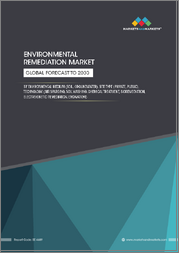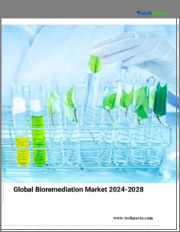
|
시장보고서
상품코드
1593483
세계의 바이오 레메디에이션 시장 - 규모, 점유율, 성장 분석 : 유형별, 기술별, 서비스별, 지역별 산업 예측(2024-2031년)Bioremediation Market Size, Share, Growth Analysis, By Type (Situ Bioremediation, And Ex Situ Bioremediation), By Technology (Biostimulation, Phytoremediation), By Service (Soil Remediation, Oilfield Remediation), By Region - Industry Forecast 2024-2031 |
||||||
바이오레메디에이션 세계 시장 규모는 2022년에 136억 1,000만 달러로 평가되었고, 2023년 149억 6,000만 달러에서 2031년에는 319억 1,000만 달러로 성장해 예측기간(2024-2031년) CAGR은 9.93%에 달할 전망입니다.
인간 활동에 의한 환경 오염의 심각화는 향후 수년간 바이오 레메디에이션 솔루션 수요를 크게 견인할 것으로 예측됩니다. 지속가능성이 중시되고 환경문제에 대한 소비자의 의식이 높아짐에 따라 바이오 레메디에이션 기업은 바이오 레메디에이션 기술의 지속적인 진보를 통해 충분한 비즈니스 차 또한 급속한 산업화와 도시화가 시장 확대에 중요한 역할을 하고 효과적인 복구 전략의 필요성을 강조합니다. 치료 기간이 길고, 오염 물질에 따라 효과가 다른 등의 과제가 시장의 진전을 방해할 가능성이 있습니다.
목차
소개
- 조사의 목적
- 정의
- 시장 범위
조사 방법
- 정보 조달
- 2차 데이터 소스와 1차 데이터 소스
- 시장 규모 예측
- 시장의 상정과 제한
주요 요약
- 시장 개요 전망
- 공급 수요 동향 분석
- 부문별 기회 분석
시장 역학과 전망
- 시장 역학
- 성장 촉진요인
- 기회
- 억제요인
- 과제
- Porter's Five Forces 분석
주요 시장 인사이트
- 주요 성공 요인
- 경쟁도
- 주요 투자 기회
- 시장 생태계
- 규제 분석
- 기술의 진보
- 가격 분석
바이오 레메디에이션 시장 : 유형별
- 시장 개요
- 현장 내 바이오 레메디에이션
- 현장외 바이오레메디에이션
바이오 레메디에이션 시장 : 기술별
- 시장 개요
- 바이오 자극
- 식물에 의한 정화
- 바이오리액터
- 곰팡이 제거
- 바이오 어그멘테이션
- 육상 치료
바이오 레메디에이션 시장 : 서비스별
- 시장 개요
- 토양 수리
- 유전 수리
- 폐수 정화
- 기타
바이오 레메디에이션 시장 : 지역별
- 시장 개요
- 북미
- 미국
- 캐나다
- 유럽
- 독일
- 스페인
- 프랑스
- 영국
- 이탈리아
- 기타 유럽
- 아시아태평양
- 중국
- 인도
- 일본
- 한국
- 기타 아시아태평양
- 라틴아메리카
- 브라질
- 기타 라틴아메리카
- 중동 및 아프리카(MEA)
- GCC 국가
- 남아프리카
- 기타 중동 및 아프리카
경쟁 구도
- 상위 5개사 비교
- 주요 기업의 시장 포지셔닝(2023년)
- 주요 시장 기업이 채용한 전략
- 시장에서의 최근 활동
- 주요 기업의 시장 점유율(2023년)
주요 기업 프로파일
- Xylem, Inc.(US)
- Aquatech International LLC(US)
- Newterra Ltd.(Canada)
- Altogen Labs(US)
- InSitu Remediation Services Limited(Canada)
- Probiosphere(Canada)
- Ivey International, Inc.(Canada)
- Sumas Remediation Services, Inc.(US)
- Sarva Bio Remed, LLC(India)
- Envirogen Technologies(US)
- Drylet, Inc.(US)
- Regenesis Corp.(US)
- MicroGen Biotech Ltd.(Ireland)
- Oil Spill Eater International, Inc.(US)
- Texas A&M AgriLife(US)
- Allonnia(US)
Global Bioremediation Market size was valued at USD 13.61 billion in 2022 and is poised to grow from USD 14.96 billion in 2023 to USD 31.91 billion by 2031, growing at a CAGR of 9.93% in the forecast period (2024-2031).
The escalating levels of environmental pollution due to human activities are anticipated to significantly drive the demand for bioremediation solutions in the coming years. The enforcement of stringent environmental protection regulations and the introduction of initiatives aimed at restoring ecosystems are expected to further bolster the growth of the bioremediation market. As sustainability becomes a central focus and consumer awareness around environmental issues rises, bioremediation companies are likely to discover ample opportunities through the ongoing advancements in bioremediation technology. Additionally, rapid industrialization and urbanization will play a crucial role in expanding the market, emphasizing the need for effective remediation strategies. However, challenges such as limited public understanding of bioremediation, the lengthy duration of treatment processes, and variable efficacy against different contaminants may hinder market progress. Overall, the bioremediation market is poised for growth, provided stakeholders address these constraints and leverage the increasing emphasis on sustainable environmental practices.
Top-down and bottom-up approaches were used to estimate and validate the size of the Global Bioremediation market and to estimate the size of various other dependent submarkets. The research methodology used to estimate the market size includes the following details: The key players in the market were identified through secondary research, and their market shares in the respective regions were determined through primary and secondary research. This entire procedure includes the study of the annual and financial reports of the top market players and extensive interviews for key insights from industry leaders such as CEOs, VPs, directors, and marketing executives. All percentage shares split, and breakdowns were determined using secondary sources and verified through Primary sources. All possible parameters that affect the markets covered in this research study have been accounted for, viewed in extensive detail, verified through primary research, and analyzed to get the final quantitative and qualitative data.
Global Bioremediation Market Segmental Analysis
Global Bioremediation Market is segmented on the type, technology, service, and region. By type, market is segmented into in situ bioremediation, and ex situ bioremediation. By technology, the market is segmented into Biostimulation, Phytoremediation, Bioreactors, Fungal Remediation, Bioaugmentation, and Land-based Treatment. By service, the market is segmented into Soil Remediation, Oilfield Remediation, Wastewater Remediation, and Others. By region, the market is segmented into North America, Europe, Asia Pacific, Middle East and Africa, and Latin America.
Driver of the Global Bioremediation Market
The global bioremediation market is being significantly driven by the relentless pace of industrialization and urbanization, which are leading to escalating levels of environmental pollution. As industries expand and urban areas proliferate, the resulting discharge of hazardous waste and pollutants into air, soil, and water bodies poses considerable risks to ecosystems and human health. This alarming rise in contaminants has intensified the urgency for effective remediation solutions, positioning bioremediation as a critical and sustainable approach to restoring polluted environments. As the recognition of climate change escalates, the demand for bioremediation technologies is expected to surge, fostering market growth and innovation.
Restraints in the Global Bioremediation Market
A significant market restraint for the global bioremediation industry is the lack of awareness surrounding the concept and its benefits, particularly in developing and underdeveloped countries. This limited understanding hampers the adoption of bioremediation technologies and methods, making it difficult for stakeholders to appreciate their efficacy in addressing environmental contamination. Additionally, the absence of educational initiatives and outreach programs exacerbates the issue, resulting in slow acceptance and integration of bioremediation solutions into existing environmental management practices. Consequently, the growth potential of the bioremediation market remains stifled due to this critical awareness gap among potential users and decision-makers.
Market Trends of the Global Bioremediation Market
The Global Bioremediation market is increasingly witnessing a shift towards the utilization of genetically engineered microorganisms, driven by rapid advancements in genetic engineering technology. This trend enables bioremediation providers to enhance the efficiency and speed of environmental cleanup processes, addressing diverse contaminants more effectively. As awareness of environmental sustainability grows and regulatory pressures intensify, companies are exploring innovative solutions that harness genetically modified organisms to tackle pollution challenges. This strategic focus not only improves performance outcomes for remediation projects but also opens new avenues for research and development, positioning bioremediation firms at the forefront of environmental restoration efforts in a competitive market landscape.
Table of Contents
Introduction
- Objectives of the Study
- Definitions
- Market Scope
Research Methodology
- Information Procurement
- Secondary & Primary Data Sources
- Market Size Estimation
- Market Assumptions & Limitations
Executive Summary
- Market Overview Outlook
- Supply Demand Trend Analysis
- Segmental Opportunity Analysis
Market Dynamics & Outlook
- Market Dynamics
- Drivers
- Opportunities
- Restraints
- Challenges
- Porters Analysis
- Competitive rivalry
- Threat of Substitute Products
- Bargaining Power of Buyers
- Threat of New Entrants
- Bargaining Power of Suppliers
Key Market Insights
- Key Success Factor
- Degree of Competition
- Top Investment Pockets
- Ecosystem of the Market
- Regulatory Analysis
- Technological Advancement
- Pricing Analysis
Bioremediation Market, By Type
- Market Overview
- In Situ Bioremediation
- Ex Situ Bioremediation
Bioremediation Market, By Technology
- Market Overview
- Biostimulation
- Phytoremediation
- Bioreactors
- Fungal Remediation
- Bioaugmentation
- Land-based Treatment
Bioremediation Market, By Service
- Market Overview
- Soil Remediation
- Oilfield Remediation
- Wastewater Remediation
- Others
Bioremediation Market Size by Region
- Market Overview
- North America
- USA
- Canada
- Europe
- Germany
- Spain
- France
- UK
- Italy
- Rest of Europe
- Asia Pacific
- China
- India
- Japan
- South Korea
- Rest of Asia-Pacific
- Latin America
- Brazil
- Rest of Latin America
- Middle East & Africa (MEA)
- GCC Countries
- South Africa
- Rest of MEA
Competitive Landscape
- Top 5 Player Comparison
- Market Positioning of Key Players, 2023
- Strategies Adopted by Key Market Players
- Recent Activities in the Market
- Key Companies Market Share (%), 2023
Key Company Profiles
- Xylem, Inc. (US)
- Company Overview
- Business Segment Overview
- Financial Updates
- Key Developments
- Aquatech International LLC (US)
- Company Overview
- Business Segment Overview
- Financial Updates
- Key Developments
- Newterra Ltd. (Canada)
- Company Overview
- Business Segment Overview
- Financial Updates
- Key Developments
- Altogen Labs (US)
- Company Overview
- Business Segment Overview
- Financial Updates
- Key Developments
- InSitu Remediation Services Limited (Canada)
- Company Overview
- Business Segment Overview
- Financial Updates
- Key Developments
- Probiosphere (Canada)
- Company Overview
- Business Segment Overview
- Financial Updates
- Key Developments
- Ivey International, Inc. (Canada)
- Company Overview
- Business Segment Overview
- Financial Updates
- Key Developments
- Sumas Remediation Services, Inc. (US)
- Company Overview
- Business Segment Overview
- Financial Updates
- Key Developments
- Sarva Bio Remed, LLC (India)
- Company Overview
- Business Segment Overview
- Financial Updates
- Key Developments
- Envirogen Technologies (US)
- Company Overview
- Business Segment Overview
- Financial Updates
- Key Developments
- Drylet, Inc. (US)
- Company Overview
- Business Segment Overview
- Financial Updates
- Key Developments
- Regenesis Corp. (US)
- Company Overview
- Business Segment Overview
- Financial Updates
- Key Developments
- MicroGen Biotech Ltd. (Ireland)
- Company Overview
- Business Segment Overview
- Financial Updates
- Key Developments
- Oil Spill Eater International, Inc. (US)
- Company Overview
- Business Segment Overview
- Financial Updates
- Key Developments
- Texas A&M AgriLife (US)
- Company Overview
- Business Segment Overview
- Financial Updates
- Key Developments
- Allonnia (US)
- Company Overview
- Business Segment Overview
- Financial Updates
- Key Developments















